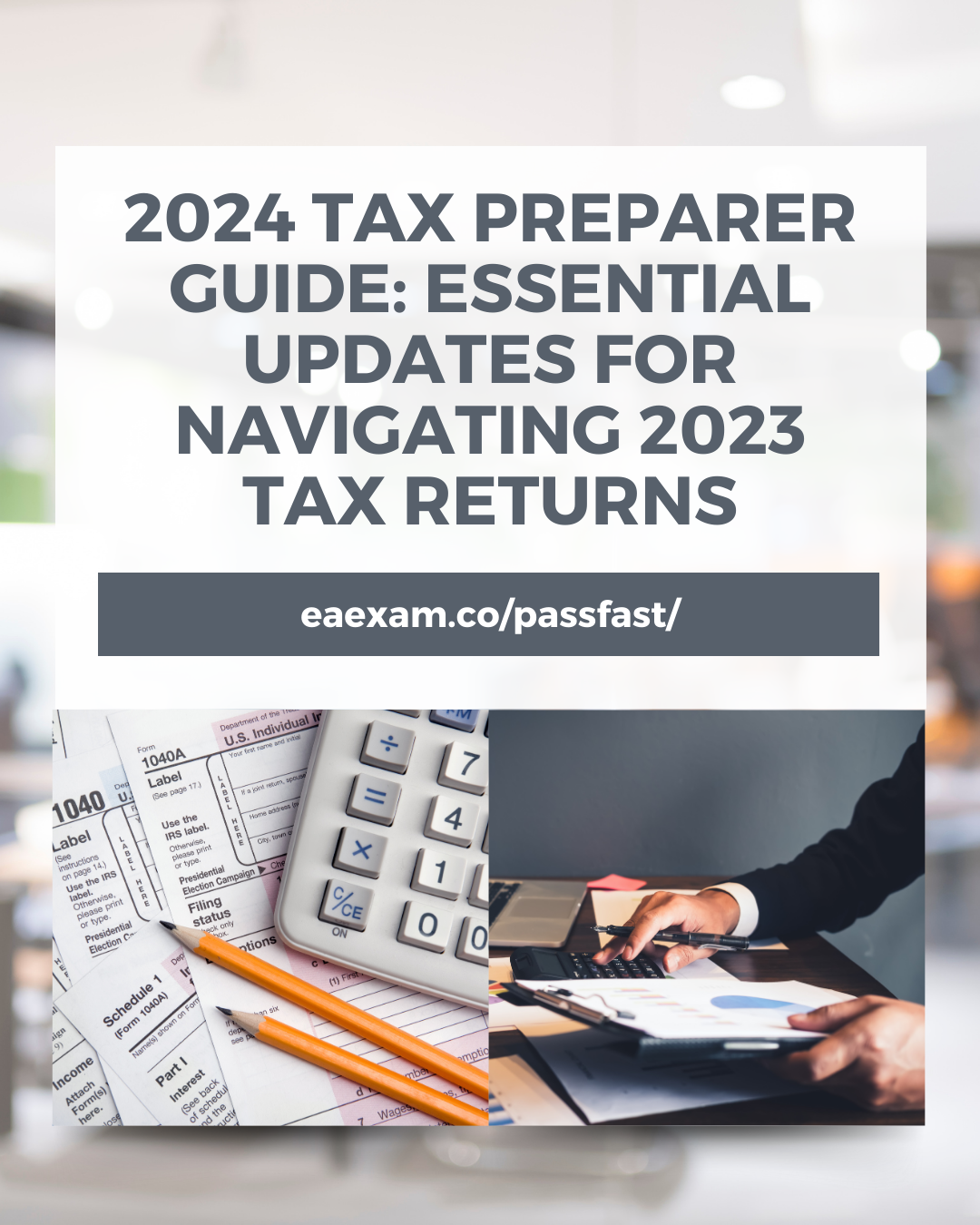Become an Enrolled Agent: Step-by-Step Guide
Passing the Enrolled Agent (EA) exam opens the door to...

| Type of Return (calendar year) | Due Date | Extended Due Date | Notes |
|---|---|---|---|
| To Employer – Form W-2* | January 31, 2023 | 1 non-automatic 30-day extension | Due date for providing W-2 to employees and to SSA. |
| To Recipient – Form 1099-NEC** | January 31, 2023 | 1 non-automatic 30-day extension | For reporting non-employee compensation. |
| To Recipient – Form 1099-MISC*** | January 31, 2023 | 1 non-automatic 30-day extension | For reporting all other payments. |
| Partnerships, LLCs – Form 1065**** | March 15, 2023 | September 15, 2023 | Also the due date for Schedule K-1, K-2 and K-3 that entity must provide to equity holders. |
| S Corporations – Form 1120S**** | March 15, 2023 | September 15, 2023 | Also the due date for Schedule K-1, K-2 and K-3 that entity must provide to equity holders. |
| Estates and Trusts – Form 1041 | April 18, 2023 | September 30, 2023 | – |
| FBAR – FinCEN Form 114 | April 18, 2023 | October 16, 2023 | – |
| Corporations – Form 1120 | April 18, 2023 | October 16, 2023 | – |
| Individuals – Form 1040***** | April 18, 2023 | October 16, 2023 | April 17, 2023 is Emancipation Day in D.C., a federal holiday and Patriot’s Day for taxpayers living in Maine or Massachusetts. |
| Exempt Organizations – Forms 990 | May 15, 2023 | November 15, 2023 | – |
| Employee Benefit Plans – Form 5500 | July 31, 2023 | October 16, 2023 | – |
| Purpose | Rate (cents per mile) | Effective Date | Additional Notes |
|---|---|---|---|
| Business | 65.5 | Travel on or after Jan. 1, 2023 | – |
| Charitable | 14.0 | Travel on or after Jan. 1, 2023 | – |
| Medical and Moving* | 22.0 | Travel on or after Jan. 1, 2023 | *For tax years 2018-2025, moving mileage may be deducted only by active duty members of the Armed Forces of the United States. |
| Taxable Income Range | Tax Due |
|---|---|
| Not over $22,000 | 10% of the taxable income |
| Over $22,000 to $89,450 | $2,200.00 plus 12% of excess over $22,000 |
| Over $89,450 to $190,750 | $10,294.00 plus 22% of excess over $89,450 |
| Over $190,750 to $364,200 | $32,580.00 plus 24% of excess over $190,750 |
| Over $364,200 to $462,500 | $74,208.00 plus 32% of excess over $364,200 |
| Over $462,500 to $693,750 | $105,664.00 plus 35% of excess over $462,500 |
| Over $693,750 | $186,601.50 plus 37% of excess over $693,750 |
| Taxable Income Range | Tax Due |
|---|---|
| Not over $15,700 | 10% of the taxable income |
| Over $15,700 to $59,850 | $1,570.00 plus 12% of excess over $15,700 |
| Over $59,850 to $95,350 | $6,868.00 plus 22% of excess over $59,850 |
| Over $95,350 to $182,100 | $14,678.00 plus 24% of excess over $95,350 |
| Over $182,100 to $231,250 | $35,498.00 plus 32% of excess over $182,100 |
| Over $231,250 to $578,100 | $51,226.00 plus 35% of excess over $231,250 |
| Over $578,100 | $172,623.50 plus 37% of excess over $578,100 |
| Taxable Income Range | Tax Due |
|---|---|
| Not over $11,000 | 10% of the taxable income |
| Over $11,000 to $44,725 | $1,100.00 plus 12% of excess over $11,000 |
| Over $44,725 to $95,375 | $5,147.00 plus 22% of excess over $44,725 |
| Over $95,375 to $182,100 | $16,290.00 plus 24% of excess over $95,375 |
| Over $182,100 to $231,250 | $37,104.00 plus 32% of excess over $182,100 |
| Over $231,250 to $578,125 | $52,832.00 plus 35% of excess over $231,250 |
| Over $578,125 | $174,238.25 plus 37% of excess over $578,125 |
| Taxable Income Range | Tax Due |
|---|---|
| Not over $11,000 | 10% of the taxable income |
| Over $11,000 to $44,725 | $1,100.00 plus 12% of excess over $11,000 |
| Over $44,725 to $95,375 | $5,147.00 plus 22% of excess over $44,725 |
| Over $95,375 to $182,100 | $16,290.00 plus 24% of excess over $95,375 |
| Over $182,100 to $231,250 | $37,104.00 plus 32% of excess over $182,100 |
| Over $231,250 to $346,875 | $52,832.00 plus 35% of excess over $231,250 |
| Over $346,875 | $93,300.75 plus 37% of excess over $346,875 |
| Filing Status | AMT Exemption Amount |
|---|---|
| Married Filing Jointly | $126,500 |
| Single/Head of Household | $81,300 |
| Married Filing Separate Returns | $63,250 |
| Estates and Trusts | $28,400 |
| Filing Status | Income Above Which 28% Rate Applies |
|---|---|
| Married Filing Jointly, Single / Head of Household, Estates and Trusts | $220,700 |
| Married Filing Separate Returns | $110,350 |
| Filing Status | Phaseout Range |
|---|---|
| Married Filing Jointly | $1,156,300 – $1,662,300 |
| Single/Head of Household | $578,150 – $903,350 |
| Married Filing Separate Returns | $578,150 – $831,150 |
| Estates and Trusts | $94,600 – $208,200 |
| Filing Status | Standard Deduction Amount |
|---|---|
| Married Filing Jointly and Surviving Spouses | $27,700 |
| Heads of Households | $20,800 |
| All Other Taxpayers | $13,850 |
| Situation | Additional Deduction Amount |
|---|---|
| Aged or Blind | $1,500 for each |
| Aged or Blind if Unmarried and Not a Surviving Spouse | $1,850 |
| Description | Amount |
|---|---|
| §179 Expensing Limit | $1,160,000 |
| §179 Property Cost Phaseout Begins | $2,890,000 |
| Capital Gains Rate | Income Range |
|---|---|
| 0% | $0 to $44,624 |
| 15% | $44,625 to $492,299 |
| 20% | $492,300 or more |
| Capital Gains Rate | Income Range |
|---|---|
| 0% | $0 to $89,249 |
| 15% | $89,250 to $553,849 |
| 20% | $553,850 or more |
| Capital Gains Rate | Income Range |
|---|---|
| 0% | $0 to $59,749 |
| 15% | $59,750 to $523,049 |
| 20% | $523,050 or more |
| Capital Gains Rate | Income Range |
|---|---|
| 0% | $0 to $44,624 |
| 15% | $44,625 to $276,899 |
| 20% | $276,900 or more |
| Taxable Income Range | Tax Calculation |
|---|---|
| Not Over $2,900 | 10% of the taxable income |
| Over $2,900 but not over $10,550 | $290.00 plus 24% of the excess over $2,900 |
| Over $10,550 but not over $14,450 | $2,126.00 plus 35% of the excess over $10,550 |
| Over $14,450 | $3,491.00 plus 37% of the excess over $14,450 |
| Taxable Amount Over | Taxable Amount Not Over | Tax on Amount in 1st Column | Rate of Tax on Excess Over Amount in 1st Column |
|---|---|---|---|
| $0 | $10,000 | $0 | 18% of the taxable amount |
| $10,000 | $20,000 | $1,800 plus | 20% of the excess over $10,000 |
| $20,000 | $40,000 | $3,800 plus | 22% of the excess over $20,000 |
| $40,000 | $60,000 | $8,200 plus | 24% of the excess over $40,000 |
| $60,000 | $80,000 | $13,000 plus | 26% of the excess over $60,000 |
| $80,000 | $100,000 | $18,200 plus | 28% of the excess over $80,000 |
| $100,000 | $150,000 | $23,800 plus | 30% of the excess over $100,000 |
| $150,000 | $250,000 | $38,800 plus | 32% of the excess over $150,000 |
| $250,000 | $500,000 | $70,800 plus | 34% of the excess over $250,000 |
| $500,000 | $750,000 | $155,800 plus | 37% of the excess over $500,000 |
| $750,000 | $1,000,000 | $248,300 plus | 39% of the excess over $750,000 |
| $1,000,000 | – | $345,800 plus | 40% of the excess over $1,000,000 |
| Year of Transfer | Applicable Exclusion Amount | Credit Amount |
|---|---|---|
| 2023 | $12,920,000 basic exclusion amount | $5,113,800 |
| Year of Transfer | Applicable Exclusion Amount |
|---|---|
| 2023 | $17,000 |
| Plan Type | Limit |
|---|---|
| §401(k) | $22,500 |
| §403(b) | $22,500 |
| §457 | $22,500 |
| SIMPLE | $15,500 |
| Plan Type | Limit |
|---|---|
| Other Than SIMPLE Plans | $7,500 |
| SIMPLE Plans | $3,500 |
| Description | Limit |
|---|---|
| Qualified Plans – Annual Compensation Limit | $330,000 |
| Defined Benefit Maximum Annual Benefit* | $265,000 |
| Defined Contribution — Maximum Annual Addition | $66,000 |
| “Key Employee” in Top-Heavy Plan | $215,000 |
| To Determine Maximum Account Balance in ESOP Subject to 5-Year Distribution Period | $1,330,000 |
| “Highly Compensated Employee” Threshold | $150,000 |
| To Determine Additional Account Balance Increments for ESOP Subject to 5-Year Distribution Period | $265,000 |
| SEP Compensation Threshold for Participation | $750 |
| Definition of “Control Employee” for Fringe Benefit Valuation (Reg. §1.61-21(f)(5)(i)) | $130,000 |
| Definition of “Control Employee” for Fringe Benefit Valuation (Reg. §1.61-21(f)(5)(iii)) | $265,000 |
| Description | Range or Limit |
|---|---|
| Contribution Limit | $6,500 |
| Catch-Up Contribution for Participants Age 50 or Older | $1,000 |
| Deduction Phase-Out Range for Married Filing Jointly and Participant in Employer Plan | $116,000-$136,000 |
| Deduction Phase-Out Range for Married Filing Jointly and Spouse in Employer Plan | $218,000-$228,000 |
| Deduction Phase-Out Range for Single or Head of Household and in Employer Plan | $73,000-$83,000 |
| Description | Range or Limit |
|---|---|
| Contribution Limit | $6,500 |
| Catch-Up Contribution for Participants Age 50 or Older | $1,000 |
| Contribution Phase-Out Range for Married Filing Jointly | $218,000-$228,000 |
| Contribution Phase-Out Range for Married Filing Separately | $0-$10,000 |
| Contribution Phase-Out Range for Single or Head of Household | $138,000-$153,000 |

Passing the Enrolled Agent (EA) exam opens the door to...

The journey to becoming an Enrolled Agent is both challenging...

Imagine gazing at a promising future as a tax professional.However,...

Achieving the status of an Enrolled Agent is a significant...

Are you envisioning a successful career as an Enrolled Agent?It's...